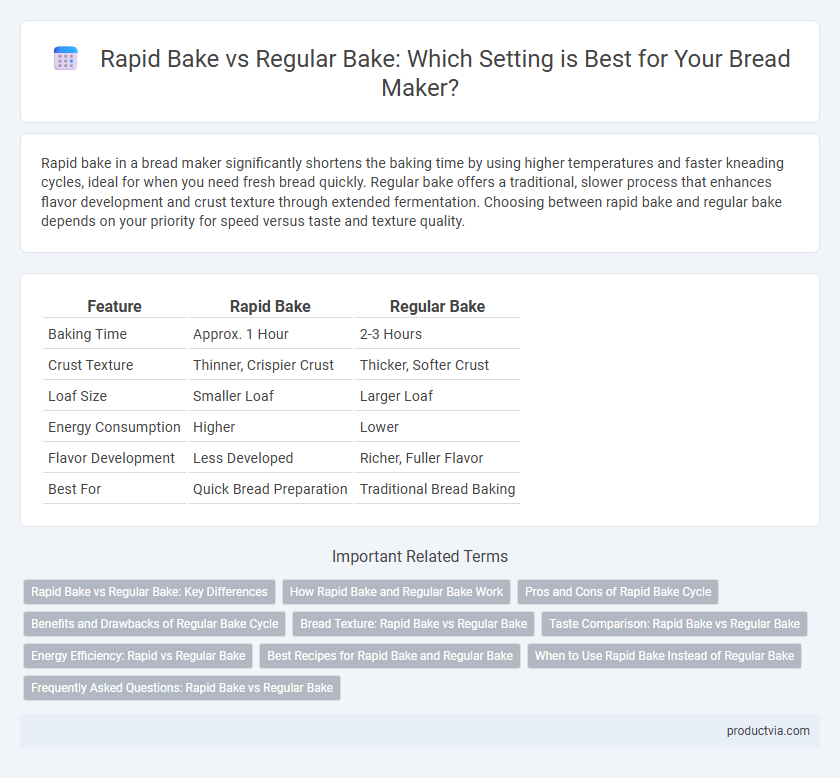Rapid bake in a bread maker significantly shortens the baking time by using higher temperatures and faster kneading cycles, ideal for when you need fresh bread quickly. Regular bake offers a traditional, slower process that enhances flavor development and crust texture through extended fermentation. Choosing between rapid bake and regular bake depends on your priority for speed versus taste and texture quality.
Table of Comparison
| Feature | Rapid Bake | Regular Bake |
|---|---|---|
| Baking Time | Approx. 1 Hour | 2-3 Hours |
| Crust Texture | Thinner, Crispier Crust | Thicker, Softer Crust |
| Loaf Size | Smaller Loaf | Larger Loaf |
| Energy Consumption | Higher | Lower |
| Flavor Development | Less Developed | Richer, Fuller Flavor |
| Best For | Quick Bread Preparation | Traditional Bread Baking |
Rapid Bake vs Regular Bake: Key Differences
Rapid bake in bread makers significantly reduces baking time by increasing temperature and speeding up yeast fermentation, resulting in bread ready typically within an hour. Regular bake cycles use a slower, more controlled process that enhances flavor development and texture by allowing longer fermentation and proofing times. Choosing rapid bake prioritizes convenience, while regular bake emphasizes traditional taste and crumb quality.
How Rapid Bake and Regular Bake Work
Rapid Bake uses higher temperatures and increased kneading speed to shorten the rising and baking times, producing bread in around an hour. Regular Bake follows a gentler process with lower temperatures and longer rising periods, allowing dough to develop flavors and textures more fully over several hours. The accelerated Rapid Bake sacrifices some depth in flavor and crumb structure compared to the slower, traditional Regular Bake method.
Pros and Cons of Rapid Bake Cycle
The Rapid Bake cycle in bread makers significantly reduces baking time, typically completing a loaf in about one hour, which is ideal for users seeking quick results. However, this fast process can sometimes compromise the bread's texture and crumb structure, leading to a denser and less airy loaf compared to the regular bake cycle. Choosing between rapid and regular bake cycles depends on whether speed or bread quality is the priority, with the regular cycle offering more consistent rise and flavor development.
Benefits and Drawbacks of Regular Bake Cycle
The regular bake cycle in a bread maker ensures thorough kneading and gradual rising, resulting in a consistent texture and rich flavor due to slower yeast fermentation, which enhances bread quality. This cycle is ideal for complex doughs and artisanal bread recipes but requires more time, typically ranging from three to four hours. The drawback includes longer preparation periods, which may be inconvenient for users seeking quick results, unlike the rapid bake cycle that sacrifices some texture and flavor for speed.
Bread Texture: Rapid Bake vs Regular Bake
Rapid bake cycles in bread makers produce loaves with a denser and slightly less even crumb texture due to the shortened rising time and faster baking temperatures. Regular bake cycles allow for extended fermentation and slower baking, resulting in a lighter, airier bread with a more consistent crumb structure. Choosing between rapid bake and regular bake affects bread texture significantly, with rapid bake favoring speed and regular bake prioritizing traditional texture quality.
Taste Comparison: Rapid Bake vs Regular Bake
Rapid bake cycles in bread makers produce bread with a quicker rise time, often resulting in a denser crumb and less developed flavor profile compared to regular bake cycles. Regular bake cycles allow longer fermentation, enhancing yeast activity that creates more complex, richer taste and better texture. Many bread enthusiasts prefer regular bake settings for superior aroma and depth of flavor, despite the shorter wait time offered by rapid bake options.
Energy Efficiency: Rapid vs Regular Bake
Rapid bake cycles in bread makers consume more energy due to higher temperatures and faster baking times, resulting in increased electricity usage compared to regular bake cycles. Regular bake cycles operate at lower temperatures over longer periods, optimizing energy consumption and enhancing overall energy efficiency. Choosing regular bake settings can reduce energy costs and environmental impact while maintaining consistent bread quality.
Best Recipes for Rapid Bake and Regular Bake
Rapid bake cycles in bread makers use higher temperatures and shorter rising times, ideal for recipes like white or whole wheat bread that require less fermentation. Regular bake cycles allow extended rising and baking, perfect for complex recipes such as sourdough, multigrain, or enriched doughs that need slower fermentation. Choosing the right cycle enhances texture and flavor, with rapid bake best for quick, simple loaves and regular bake suited for traditional, artisanal breads.
When to Use Rapid Bake Instead of Regular Bake
Rapid bake mode in a bread maker is ideal when time is limited, allowing bread to be fully baked in about half the time of a regular bake cycle. Use rapid bake for small loaves, softer crusts, or when fresh bread is needed quickly, but note it may sacrifice some texture and flavor complexity. Regular bake is better suited for achieving optimal crumb structure and crust development in larger or artisanal-style loaves.
Frequently Asked Questions: Rapid Bake vs Regular Bake
Rapid bake cycles in bread makers typically complete the baking process in under an hour, ideal for users seeking quick results without sacrificing texture. Regular bake cycles take longer, often around three to four hours, allowing for more thorough kneading and rising, which enhances flavor and crumb structure. Choosing between rapid and regular bake depends on the desired balance of time efficiency versus bread quality and taste.
Rapid bake vs regular bake for bread maker Infographic

 productvia.com
productvia.com